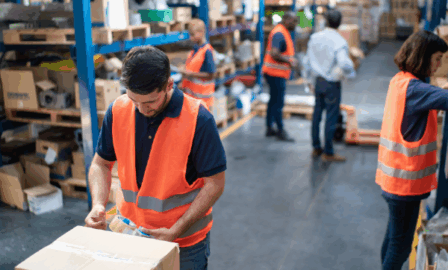Lessons Learned from the Suez Canal Blockage
The Suez Canal is one of the world’s most important trading arteries, separating the continent of Africa and the Middle East from Asia and facilitating the distribution of 12% of the global shipping traffic. This narrow canal, which first opened in 1869, saves ships an average of 4,300 miles by short-cutting the long journey around the southern tip of Africa. Who would have been able to predict that global supply chains that are still feeling the pressure from COVID-19 would once again be faced with another challenge when rough $10 billion worth of goods were blocked from entry to the canal for 6 days? The widespread effects of the Ever Given being stuck in the Suez Canal demonstrates that organizations need to be able to analyze the impacts rather than the events that can lead to supply chain disruptions.
Immediate Impacts of the Suez Canal Blockage
In the days following the blockage at the Suez Canal, not only were finished goods stuck at sea, but oil tankers, livestock, and the actual shipping containers were stranded, leaving organizations in a panic as they anxiously waited to hear that the ship was freed. A major ripple that already can be felt is that shipping container supply is constrained, and the delay due to the blockage at the Suez Canal can lead to increased shortages and future delays. Through this challenge we learned the critical importance of supply chain resilience. Companies were faced with questions such as:
- How flexible is your current sourcing, production & distribution network?
- Do you have data and systems in place that give visibility to disruptions?
- Do you have organizational structures allow you to make rapid data-based decisions on how to respond?
Ripple Effects
A handful of organizations including Nike, Gap, Steve Madden, and Tesla are attributing impacts on their business this quarter to supply chain issues. Nike even took it a step further, explicitly stating that a dip in sales volume was due to a lack of containers, leading to a 3-week delay in inventory reaching the shelves.
At the same time, some European manufactures had to delay production while they waited for parts from Asia. Specific goods, like Robusta coffee beans (which makes up the second-highest amount of the world’s coffee production), saw an increase in cost as shipping containers were left unable to reach the port and be offloaded for sales. Semiconductors – already in short supply because of higher than anticipated demand for cars and trucks, smartphones, PCs, tablets, and TVs during the pandemic – are also stuck at sea, further exacerbating the shortage.
The snowball effects of shipping container scarcity in the US and temporary shortages on finished goods in Europe caused by the Suez Canal blockage shows us that organizations need to proactively make supply chain decisions that will lead to more resilient supply chain networks. Will we see organizations relatively take short-term actions, like stockpiling parts or scrambling for new, perhaps onshore suppliers? Or will this be the driver for leaders to thoughtfully develop the supply network flexibility, organizational agility, and risk response capability that will allow them to weather future unexpected storms? One thing we know for sure is that many supply networks are still fragile and have room for more transparency and flexibility.
Subscribe to Clarkston's Insights
Contributions by Bruce Twery and Aley Morris



